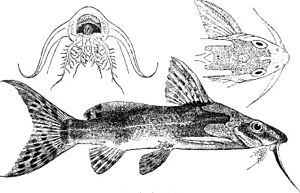Synodontis smiti facts for kids
Quick facts for kids Synodontis smiti |
|
|---|---|
 |
|
| Conservation status | |
| Scientific classification | |
| Genus: |
Synodontis
|
| Species: |
smiti
|
The Synodontis smiti, also called the longtail Synodontis or Smit's Synodontis, is a type of upside-down catfish. This fish lives only in the Democratic Republic of the Congo. You can find it in the middle and upper parts of the Congo Basin.
A British-Belgian scientist named George Albert Boulenger first described this fish in 1902. He found specimens in the Ubangi River. The name smiti honors Pierre Jacques Smit. He was an artist who drew pictures for Boulenger's books.
Contents
Meet the Longtail Synodontis
Like other Synodontis fish, S. smiti has a strong, bony head. This head covering goes all the way back to its first dorsal fin spine. The head also has a special bony part called a humeral process. Its shape helps scientists tell different Synodontis species apart. For S. smiti, this part feels rough and has a rounded or blunt end.
This fish has three pairs of barbels, which are like whiskers. One pair is on its upper jaw, and two pairs are on its lower jaw. The upper jaw barbels are straight and have a wide base. They are a bit shorter than the fish's head. The outer lower jaw barbels are about half as long as the head. The inner lower jaw barbels are about one-third as long. Both lower jaw barbels have many small branches.
Fins and Teeth
The front edges of the dorsal (top) and pectoral (side) fins are stiff spines. In S. smiti, the dorsal fin spine is a little shorter than the head. It is slightly curved, smooth in front, and rough on the back. The rest of the dorsal fin has seven soft rays. The pectoral fin spine is as long as the head and rough on both sides.
The adipose fin is a small, fleshy fin near the tail. It is four to five times longer than it is deep. The anal fin has four unbranched and six or seven branched rays. The tail fin, also called the caudal fin, has a deep notch.
All Synodontis fish have a special pad of teeth on their upper jaw. These teeth are short and shaped like chisels. In S. smiti, this toothpad is short and wide. On the lower jaw, the teeth are "s-shaped" or "hooked." They are attached to flexible stalks. Scientists count these teeth to identify species. S. smiti usually has about 16 or 17 teeth on its lower jaw.
What Does it Look Like?
The Synodontis smiti is brown. It has faint darker spots and swirly patterns. You might see round dark spots on its rayed fins. These spots can sometimes look like bands.
This fish can grow up to about 22.2 centimeters (8.7 inches) long. Female Synodontis fish are usually a bit bigger than males of the same age.
Where it Lives and What it Does
In the wild, the Synodontis smiti lives in the central and upper parts of the Congo Basin. People also catch this fish to eat.
Reproduction and Life Cycle
Scientists do not know much about how most Synodontis species reproduce. They have found eggs in some female fish. It is likely that these fish lay their eggs during the flooding season. This usually happens between July and October. During spawning, pairs of fish might swim together. Young fish grow quickly in their first year. After that, their growth slows down as they get older.


